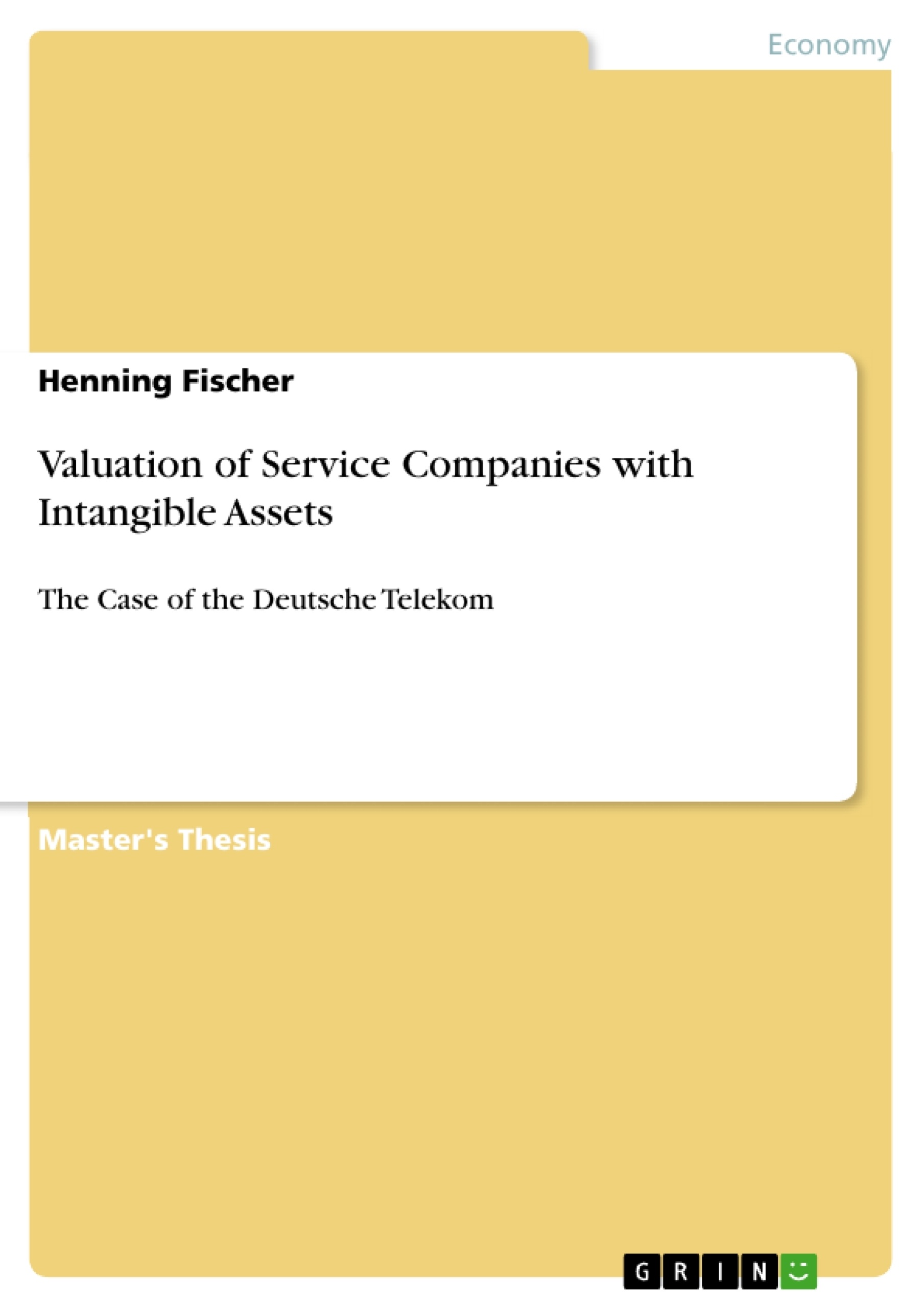The thesis addresses the issue of the valuation of service companies which have a large amount of intangible assets in their balance sheet. The problem of these assets are that it is not clear on the first view if and to what degree they are contributing to the company’s revenue and growth. This issue is discussed in the thesis with the example of Deutsche Telekom which consists to almost 40% of intangible assets. The telecom industry is presented with its trends and developments. Additionally a Porter’s five forces analysis is conducted to grant a greater overview over the industry.
The Deutsche Telekom is presented by showing the structure, key financial data, strategy, forecast and the IPO of 1996.
A discounted cash flow valuation resulting in a free cash flow to firm and a dividend discount model is used for Deutsche Telekom. Additionally the competitors AT&T and Vodafone are compared to Deutsche Telekom in the context of a financial ratio analysis and a relative valuation. The relative valuation uses the multiples PE ratio, EV/EBITDA, EV/S, P/BV and P/CF.
The thesis closes with a conclusion with the connection to intangible assets to valuation.
Inhaltsverzeichnis (Table of Contents)
- Introduction
- Choice of subject
- Literature Review
- Discounted Cash Flow Valuation
- Equity DCF Model: The Dividend Discount Model (DDM)
- Relative Valuation
- Sensitivity Analysis
- Intangible Assets
- Intangible Assets in Valuation
- Problem Discussion
- Problem Formulation
- Summary of Literature Review
- Research Methodology
- Research Objectives
- Methods and Access
- Research Philosophy
- Research Approach
- Research Strategy
- Population and Sampling
- Literature and Data Collection
- Primary Literature
- Secondary Literature
- Primary and Secondary Data
- Analysis of Results
- Reliability and Validity
- Limitations
- Research Ethics
- Summary of Theoretical Methodology
- The Telecommunication Industry
- Overview
- Key companies
- Trends and Developments
- Porter's five forces
- Threat of new entrants
- Bargaining Power of Suppliers
- Bargaining Power of Buyers
- Threat of substitutes
- Competitive Rivalry within the Industry
- Deutsche Telekom
- Profile
- Structure
- Key Financial Data
- Strategy
- Forecast
- IPO of 1996
- Financial Ratio Analysis
- Management Performance
- Margin Ratios
- Return on Investment Ratios
- Asset Utilisation Ratios
- Financial Strength
- Long-Term Solvency Risk Ratios
- Short-Term Liquidity Risk Ratios
- Summary of the Findings
- Valuation
- Intrinsic Valuation
- Model chosen
- Input Factors
- FCFF Calculation
- Sensitivity Analysis
- Dividend Discount Valuation
- Relative Valuation
Zielsetzung und Themenschwerpunkte (Objectives and Key Themes)
This dissertation explores the valuation of service companies with intangible assets, using Deutsche Telekom as a case study. It examines how the presence of intangible assets influences valuation methodologies, particularly within the telecommunications industry. The work aims to contribute to the understanding of valuation challenges specific to service companies and to provide practical insights for financial analysts and investors.
- Valuation of service companies with intangible assets
- Influence of intangible assets on valuation methodologies
- Application of valuation models in the telecommunications industry
- Case study analysis of Deutsche Telekom
- Practical implications for financial analysts and investors
Zusammenfassung der Kapitel (Chapter Summaries)
The dissertation begins with an introduction, outlining the importance of the chosen topic and the motivations behind the research. Chapter 2 provides a comprehensive literature review, exploring various valuation approaches, particularly those relevant to companies with intangible assets. The review highlights the challenges associated with valuing intangible assets and their impact on traditional valuation models. Chapter 3 delves into the research methodology, outlining the objectives, methods, and data sources used in the study. This chapter also addresses ethical considerations and potential limitations of the research. Chapter 4 provides an overview of the telecommunication industry, discussing its key characteristics, trends, and competitive landscape. The chapter analyzes the industry's dynamics through Porter's five forces framework. Chapter 5 focuses on Deutsche Telekom, providing a detailed profile of the company, including its structure, financial performance, and strategic direction. This chapter also analyzes the company's financial ratios and assesses its management performance and financial strength. Chapter 6 presents the valuation results, employing both intrinsic and relative valuation methodologies. This chapter explores the application of discounted cash flow models and dividend discount models to Deutsche Telekom, considering the impact of intangible assets on valuation. The chapter also discusses the limitations of these models and the importance of sensitivity analysis.
Schlüsselwörter (Keywords)
The main keywords of this dissertation include valuation, intangible assets, service companies, telecommunications industry, Deutsche Telekom, discounted cash flow, dividend discount model, relative valuation, financial ratio analysis, sensitivity analysis, Porter's five forces, industry dynamics, and strategic analysis.
- Quote paper
- Henning Fischer (Author), 2015, Valuation of Service Companies with Intangible Assets, Munich, GRIN Verlag, https://www.grin.com/document/310435



